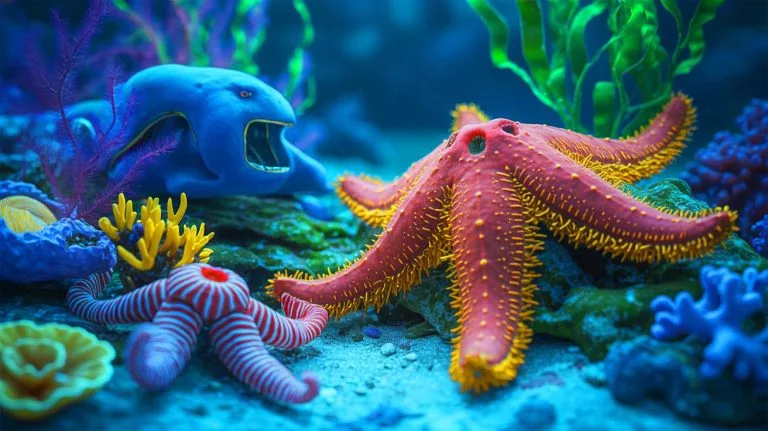| IN A NUTSHELL |
|
A pervasive marine epidemic has decimated sea star populations along North America’s Pacific coast, with the loss of billions over the past decade. Recent research has finally pinpointed the cause: a single bacterial species, Vibrio pectenicida. This discovery, published in Nature Ecology & Evolution, marks a significant step in understanding sea star wasting disease, a rapid and lethal condition that has profoundly impacted marine ecosystems. The identification of this bacterium provides a crucial target for future conservation efforts, as scientists seek to mitigate the ecological imbalance caused by the decline of these vital marine predators.
The Elusive Culprit: A Bacterial Predator
For years, the cause of sea star wasting disease remained a mystery, baffling researchers as populations continued to dwindle. Early investigations mistakenly focused on a densovirus, which was found to be a normal resident in healthy sea stars. This misdirection delayed the identification of the true pathogen. The breakthrough came when scientists shifted their focus to analyzing coelomic fluid—the internal “blood” of sea stars—rather than deceased tissue. This approach led to the detection of Vibrio pectenicida, a bacterial pathogen previously overlooked due to its poor persistence in dead specimens.
Subsequent experiments provided definitive proof of Vibrio pectenicida’s role in sea star wasting disease. Healthy sea stars, when exposed to the bacterium, quickly exhibited the characteristic symptoms of rapid tissue loss and ultimately death. This discovery has shifted the scientific community’s understanding of the disease, offering a tangible target for future research and potential interventions. Identifying the cause of this epidemic represents a pivotal moment in marine biology, highlighting the need for continued vigilance and innovative solutions.
Understanding Vibrio: From Benign to Deadly
While Vibrio bacteria are not foreign invaders, their role in the ecosystem is complex. These bacteria are integral to marine life, involved in nutrient cycling, organic matter decomposition, and maintaining overall ecosystem health. However, under certain conditions, such as warmer waters or nutrient surges, they can become opportunistic pathogens. This shift allows them to overwhelm marine organisms’ defenses with lethal efficiency.
The impact of Vibrio pectenicida on sea stars underscores the delicate balance within marine ecosystems. The death of sea stars, often seen as insignificant at first glance, can lead to dramatic shifts in the coastal environment. Without these keystone predators, ecosystems struggle to maintain equilibrium, resulting in profound changes that ripple through the food web and beyond. Understanding these dynamics is crucial for developing strategies to mitigate such transformations and protect marine biodiversity.
The Ecological Ripple Effect
The loss of sea stars has set off a chain reaction along the Pacific coast, analogous to other historical ecological imbalances. The absence of keystone predators like the sunflower sea star has allowed populations of purple sea urchins to explode unchecked. These urchins, in turn, have decimated kelp forests, reducing them to barren underwater landscapes. The loss of kelp forests has far-reaching consequences, affecting marine mammals, fish species, and the broader coastal ecosystem.
Kelp forests serve as essential nurseries and feeding grounds, and they play a critical role in climate regulation by sequestering carbon. They also act as natural buffers against storm surges and coastal erosion. In Northern California, the disappearance of over 90% of these forests has jeopardized fisheries, seabird colonies, and the overall resilience of coastal ecosystems. This ecological disruption highlights the interconnectedness of marine environments and the importance of preserving keystone species.
Path Forward: Restoration and Conservation
With the identification of Vibrio pectenicida, efforts to restore balance to the affected ecosystems are underway. Captive breeding programs, such as those at the Seattle Aquarium, aim to raise healthy sunflower sea stars for eventual reintroduction into the wild. These programs offer hope for rebuilding populations and restoring ecological stability in the intertidal zone.
The new understanding of sea star wasting disease serves as a reminder of the impact marine diseases can have on ecosystems. Just as a wildfire can devastate a forest, marine diseases can hollow out underwater habitats. With the cause now identified, scientists are better equipped to protect remaining populations and begin the long journey of ecological restoration. As these efforts progress, a critical question remains: How can we prevent similar ecological crises in the future?
Did you like it? 4.5/5 (20)





Wow, this is fascinating! How long do you think it will take for sea star populations to recover? 🌊
Wow, this is a huge breakthrough! Congrats to the scientists involved. 🎉
So, can we expect the sea stars to make a comeback soon?
Great article! But why did it take so long to identify the bacteria? 🤔
Why did it take so long to identify the bacteria? 🤔
I’m skeptical. How can we be sure this is the real cause?
What steps can be taken to prevent a similar outbreak in the future?
It’s amazing how something so small can have such a big impact.
So happy to see science making progress, but it’s a bummer this took a decade!